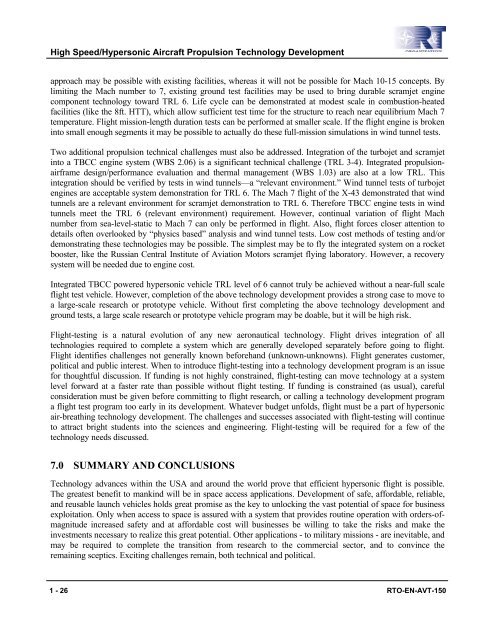High Speed/Hypersonic Aircraft Propulsion Technology Development
High Speed/Hypersonic Aircraft Propulsion Technology Development
High Speed/Hypersonic Aircraft Propulsion Technology Development
You also want an ePaper? Increase the reach of your titles
YUMPU automatically turns print PDFs into web optimized ePapers that Google loves.
<strong>High</strong> <strong>Speed</strong>/<strong>Hypersonic</strong> <strong>Aircraft</strong> <strong>Propulsion</strong> <strong>Technology</strong> <strong>Development</strong><br />
approach may be possible with existing facilities, whereas it will not be possible for Mach 10-15 concepts. By<br />
limiting the Mach number to 7, existing ground test facilities may be used to bring durable scramjet engine<br />
component technology toward TRL 6. Life cycle can be demonstrated at modest scale in combustion-heated<br />
facilities (like the 8ft. HTT), which allow sufficient test time for the structure to reach near equilibrium Mach 7<br />
temperature. Flight mission-length duration tests can be performed at smaller scale. If the flight engine is broken<br />
into small enough segments it may be possible to actually do these full-mission simulations in wind tunnel tests.<br />
Two additional propulsion technical challenges must also be addressed. Integration of the turbojet and scramjet<br />
into a TBCC engine system (WBS 2.06) is a significant technical challenge (TRL 3-4). Integrated propulsionairframe<br />
design/performance evaluation and thermal management (WBS 1.03) are also at a low TRL. This<br />
integration should be verified by tests in wind tunnels—a “relevant environment.” Wind tunnel tests of turbojet<br />
engines are acceptable system demonstration for TRL 6. The Mach 7 flight of the X-43 demonstrated that wind<br />
tunnels are a relevant environment for scramjet demonstration to TRL 6. Therefore TBCC engine tests in wind<br />
tunnels meet the TRL 6 (relevant environment) requirement. However, continual variation of flight Mach<br />
number from sea-level-static to Mach 7 can only be performed in flight. Also, flight forces closer attention to<br />
details often overlooked by “physics based” analysis and wind tunnel tests. Low cost methods of testing and/or<br />
demonstrating these technologies may be possible. The simplest may be to fly the integrated system on a rocket<br />
booster, like the Russian Central Institute of Aviation Motors scramjet flying laboratory. However, a recovery<br />
system will be needed due to engine cost.<br />
Integrated TBCC powered hypersonic vehicle TRL level of 6 cannot truly be achieved without a near-full scale<br />
flight test vehicle. However, completion of the above technology development provides a strong case to move to<br />
a large-scale research or prototype vehicle. Without first completing the above technology development and<br />
ground tests, a large scale research or prototype vehicle program may be doable, but it will be high risk.<br />
Flight-testing is a natural evolution of any new aeronautical technology. Flight drives integration of all<br />
technologies required to complete a system which are generally developed separately before going to flight.<br />
Flight identifies challenges not generally known beforehand (unknown-unknowns). Flight generates customer,<br />
political and public interest. When to introduce flight-testing into a technology development program is an issue<br />
for thoughtful discussion. If funding is not highly constrained, flight-testing can move technology at a system<br />
level forward at a faster rate than possible without flight testing. If funding is constrained (as usual), careful<br />
consideration must be given before committing to flight research, or calling a technology development program<br />
a flight test program too early in its development. Whatever budget unfolds, flight must be a part of hypersonic<br />
air-breathing technology development. The challenges and successes associated with flight-testing will continue<br />
to attract bright students into the sciences and engineering. Flight-testing will be required for a few of the<br />
technology needs discussed.<br />
7.0 SUMMARY AND CONCLUSIONS<br />
<strong>Technology</strong> advances within the USA and around the world prove that efficient hypersonic flight is possible.<br />
The greatest benefit to mankind will be in space access applications. <strong>Development</strong> of safe, affordable, reliable,<br />
and reusable launch vehicles holds great promise as the key to unlocking the vast potential of space for business<br />
exploitation. Only when access to space is assured with a system that provides routine operation with orders-ofmagnitude<br />
increased safety and at affordable cost will businesses be willing to take the risks and make the<br />
investments necessary to realize this great potential. Other applications - to military missions - are inevitable, and<br />
may be required to complete the transition from research to the commercial sector, and to convince the<br />
remaining sceptics. Exciting challenges remain, both technical and political.<br />
1 - 26 RTO-EN-AVT-150

















